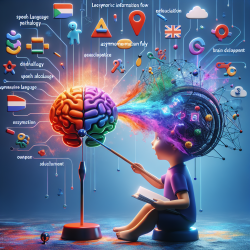Introduction
In the field of speech-language pathology, understanding the neurological underpinnings of language development is crucial for designing effective interventions. Recent research by Sharma et al. (2023) titled "Asymmetric information flow in brain networks supporting expressive language in childhood" provides valuable insights into how brain networks support expressive language in children. This blog post will explore the key findings of this research and discuss how practitioners can apply these insights to improve outcomes for children with language development challenges.
Understanding Asymmetric Information Flow
The study by Sharma et al. (2023) utilized magnetoencephalography (MEG) to analyze the brain activity of 80 children and adolescents aged 4 to 19 years. The researchers focused on event-related desynchrony (ERD) and event-related synchrony (ERS) in the low-beta frequency band, which are neural signatures of expressive language. They found that as children age, there is a lateralization of ERD to the left hemisphere, associated with language production, while ERS lateralizes to the right hemisphere, indicating inhibition.
This asymmetric information flow suggests that the left hemisphere increasingly drives language networks, whereas the right hemisphere plays a role in suppressing information flow. The study highlights the importance of the left inferior frontal gyrus (IFG), commonly known as Broca's area, as a driver in the language network. In contrast, the right IFG acts as a receiver without propagating information further.
Implications for Practitioners
For speech-language pathologists, these findings underscore the importance of targeting specific brain regions in therapeutic interventions. Here are some actionable steps practitioners can take:
- Focus on the Left Hemisphere: Given the role of the left hemisphere in driving language networks, interventions should aim to stimulate and strengthen this area. Activities that promote expressive language skills, such as storytelling and role-playing, can be beneficial.
- Monitor Right Hemisphere Activity: Understanding the inhibitory role of the right hemisphere can help practitioners design strategies that minimize its suppressive effects. Techniques such as rhythmic speech and prosody training may enhance the balance between hemispheres.
- Incorporate Neuroimaging Insights: Utilizing tools like MEG or functional MRI in assessments can provide a clearer picture of a child's brain activity, allowing for more personalized intervention plans.
Encouraging Further Research
The study by Sharma et al. opens new avenues for research in language development. Practitioners are encouraged to stay informed about ongoing studies and consider participating in research collaborations. By contributing to the growing body of knowledge, speech-language pathologists can help refine therapeutic approaches and improve outcomes for children with language disorders.
Conclusion
Understanding the asymmetric information flow in brain networks is a significant step forward in the field of speech-language pathology. By applying these insights, practitioners can develop more effective interventions that cater to the unique neurological profiles of children. As we continue to unravel the complexities of language development, the potential for creating positive outcomes for children is immense.
To read the original research paper, please follow this link: Asymmetric information flow in brain networks supporting expressive language in childhood.










